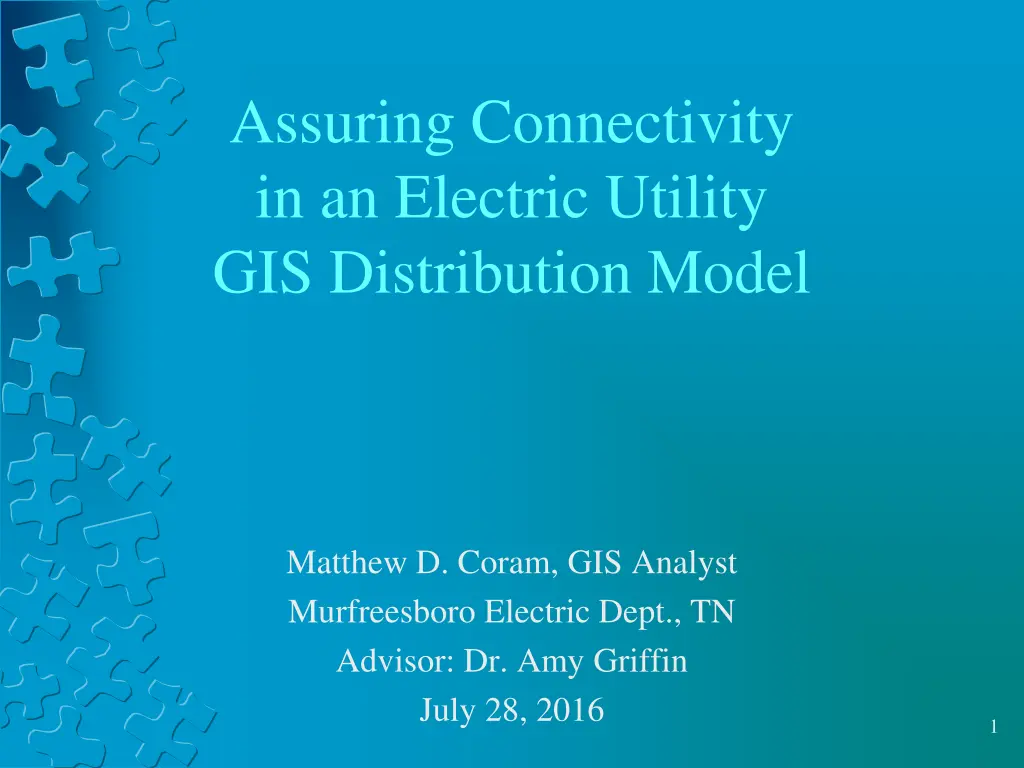
Ensuring Connectivity in Electric Utility GIS Distribution Model
Explore how an electric utility GIS distribution model by Matthew D. Coram ensures connectivity, using ESRI's GeoConX conference for presentation and completion by early spring 2017. Learn about the GIS Department at Murfreesboro Electric Dept., workflows, spans, edges, and background information on electrical lines.
Download Presentation

Please find below an Image/Link to download the presentation.
The content on the website is provided AS IS for your information and personal use only. It may not be sold, licensed, or shared on other websites without obtaining consent from the author. If you encounter any issues during the download, it is possible that the publisher has removed the file from their server.
You are allowed to download the files provided on this website for personal or commercial use, subject to the condition that they are used lawfully. All files are the property of their respective owners.
The content on the website is provided AS IS for your information and personal use only. It may not be sold, licensed, or shared on other websites without obtaining consent from the author.
E N D
Presentation Transcript
Assuring Connectivity in an Electric Utility GIS Distribution Model Matthew D. Coram, GIS Analyst Murfreesboro Electric Dept., TN Advisor: Dr. Amy Griffin July 28, 2016 1
Timeline Work began: Spring 2016 Class and presentation: July 28, 2016 Presentation: ESRI s GeoConX conference during the week of October 2016 in Phoenix, AZ Project Completion: Early Spring 2017 2
About MED and the GIS Department Murfreesboro is 30 minutes southeast of Nashville Municipal Electric Utility with approximately 58,000 electric meters GIS Department is a subset of IT and supports every other department Weekly workflows include importing of developer CAD files and conversion of constructed electric lines into master database 3
Spans and Edges ESRI s Geometric Network Model - Edges o Simple Edge Line where all of the flow entering is equal to all of the flow leaving o Complex Edges Line where all of the flow may be split among the end and laterals o Complex edge may be thought of as multiple simple edges 4
Spans and Edges MED uses simple edges exclusively Junctions (point features) present at all span endpoints A simple edge may be split into two simple edges when a new tap is constructed 5
Spans and Edges Example of Simple Edge Junction 1630 Valve 102 6
Spans and Edges Example of Complex Edge Junction 1630 Junction 1842 Valve 102 7
Background Traditional GIS used an attribute-based numbering system for electrical lines Newer systems have moved toward a GUID- based approach Database tables are designed to be normalized and to help prevent unwanted data changes Meaning of electrical spans 8
Conversion Legacy GIS used non-intersecting spans ESRI-based system requires spans to be snapped together Connectivity is our focus Other systems rely on GIS data, so accuracy is key 9
Connectivity Every piece of equipment and all lines on a circuit are interconnected Some coincident features may not have connectivity Double Circuits 10
Connectivity Relationships, endpoints, and insertion points are important Feature dataset table with a related stand-alone table Two sources must be in agreement for connectivity to work properly 11
Dilemma Many instances of disagreement between two data sources These issues can interrupt connectivity Difficult to detect until each instance is found through editing Span endpoints may be inches or feet apart 12
Application Operation Begins at the substation (source) Steps through each junction and span Junctions with multiple downstream spans must be remembered At the end of each branch, program begins on next unprocessed branch Program continues until each branch has been checked, then starts on next circuit 13
Application Operation - Example Span endpoints are not snapped to one another 14
Application Operation - Example all_relationships table indicates no issues with the connectivity 15
Application Operation - Example Likely that some or all of the downstream features will be disconnected In the OMS, customers may be out of power but may not be reported correctly Customer relations may be impacted 16
Custom Application Custom solution is needed to identify issues Primary and Secondary network issues may potentially be identified Dealing with a third-party provider, so a data export is needed Exported data will be operated upon and return a separate feature dataset for import to GIS Overlay Analysis allows new dataset to highlight problem areas 17
Network Types Primary Higher Voltages Secondary Lower Voltages Transformer is the dividing line between the two network types Primary and Secondary network issues may potentially be identified by the application 18
Network Types Primary Red Lines Secondary Orange Lines Transformers Red Triangles Meters Green Symbols 19
Custom Application Use of vendor-supplied tools to correct broken connectivity New dataset to have attribute for tracking when corrections have taken place 20
Custom Application Entity Relationship Diagram (ERD) Relates the all_spans feature dataset to the all_relationships connectivity table all_spans all_relationships span_id relationship_id span_type relationship_feature_id phase_id upstream_relationship_id map_feature_id map_feature_type 21
Application Return on Investment Errors of this type cannot be automatically detected without the application Estimates o Manual correction (after research) can take between 5 and 10 minutes o Number of system-wide errors may range from 500 to 1,000 22
Application Return on Investment Research per Primary spans o ((0.5 min * 22,500 spans) / 60 min per hour) = 187.5 working man-hours Error Repair for Primary spans o ((10 min * 1,000 errors) / 60 min per hour) = 166.67 working man-hours Total of 354.17 man-hours or approximately 8.8 man-weeks (10 12 weeks more realistic?) Secondary networks more numerous, longer time 23
Application Whats down the road? Conversion from Microsoft Access Visual Basic for Applications (VBA) C# (.NET) is likely the preferred language Possible move from storage of data in MS Access to MS SQL Server Improved tracking in program development Increased execution speed Ability to interact with the map document 24
Application Goals Detect issues with connectivity Mark those errors for manual correction Facilitate correction and minimal tracking for editor convenience Increase confidence in the OMS Increase confidence in the Engineering Model to accurately predict growth 25
Questions? 26
Sources Environmental Systems Research Institute, Inc. (n.d.). ArcGIS Help. Retrieved July 27, 2016, from http://desktop.arcgis.com/en/arcmap/10.3/manage-data/geodatabases/design-an-overview- of-table-properties.htm Environmental Systems Research Institute, Inc. (n.d.). ArcGIS Help. Retrieved June 30, 2016, from http://desktop.arcgis.com/en/arcmap/10.3/manage-data/geodatabases/exercise-5-building- a-geometric-network.htm Environmental Systems Research Institute, Inc. (n.d.). ArcMap. Retrieved June 30, 2016, from http://desktop.arcgis.com/en/arcmap/latest/manage-data/geometric-networks/about-creating- geometric-networks.htm Environmental Systems Research Institute, Inc. (n.d.). ArcMap. Retrieved June 30, 2016, from http://desktop.arcgis.com/en/arcmap/latest/manage-data/geometric-networks/what-are- geometric-networks-.htm Environmental Systems Research Institute, Inc. (n.d.). ArcMap. Retrieved June 30, 2016, from http://desktop.arcgis.com/en/arcmap/latest/manage-data/geometric-networks/a-quick-tour-of- geometric-networks.htm ESRI 2011. ArcGIS Desktop: Release 10.2.2. Redlands, CA: Environmental Systems Research Institute. 27
Sources Gilgrass, C., & Hoel, E. (2012, July 26). Geometric Networks: An Introduction. Retrieved June 30, 2016, from http://video.esri.com/watch/2012/geometric-networks-an-introduction Microsoft, Inc. (2010). Microsoft Access: Release 2010. Redmond, WA: Microsoft, Inc. Murfreesboro Electric Department. (2016). MEDGIS01 [SQL Server Database]. Murfreesboro, TN: Murfreesboro Electric Department. Rahm, E., & Do, H. (2000). Data cleaning: Problems and current approaches. IEEE Data Eng. Bull., 23(4), 3 13. http://doi.org/10.1145/1317331.1317341 O Sullivan, D. (2014). GEOG 586 - Geographic Information Analysis. The Pennsylvania State University. Retrieved April 5, 2016 from https://www.e- education.psu.edu/geog586spring2/ 28


